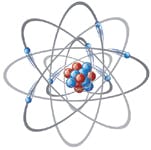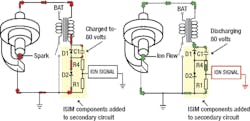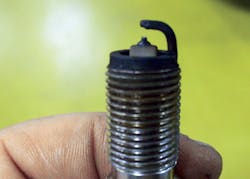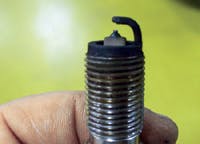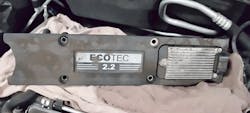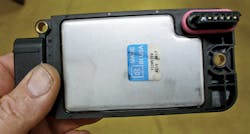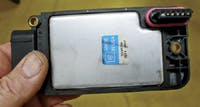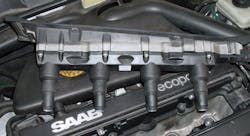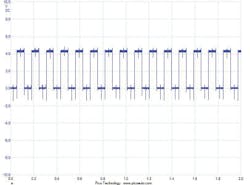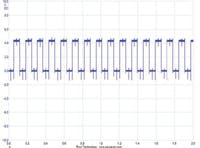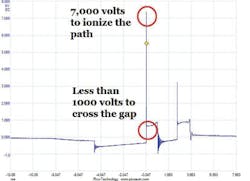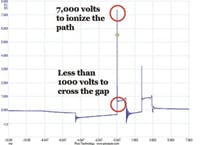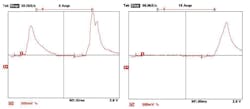Here's a means of assessing the combusion process that may see renewed interest by the OEMs.
What Is An Ion?
An ion is an atom or group of atoms that has more (or fewer) electrons than it does protons. If there are more electrons than protons, it is negatively charged and is called an anion. If there are fewer electrons, it is positively charged and is called a cation.
You might have heard of ionization in reference to an ignition system before, but in a different context. If the spark plug is located in an electrical path, the gap between the center electrode and the ground electrode would certainly have to be considered open in that circuit. But if enough electromotive force is generated, the atoms in that gap will begin to ionize to the point of plasma. These ionized particles conduct electricity just fine, and the plug fires. It is this burn line that many technicians have been using for years to identify problems in the combustion chamber. Compression problems, mixture problems and ignition problems all can affect this burn line in unique ways.The chemical and thermal reactions that occur during the combustion process also cause ionization, and according to researchers like Lars Eriksson (who wrote Spark-Advance Control by Ion-Sensing and Interpretation in 1998), the post combustion phase is both stable and consistent enough to be used for information on the combustion process.
In other words, it can be used to tell the engine control module the same thing it tells technicians viewing the secondary pattern and even a bit more.Ion Sensing Ignition Systems
Ion sensing systems are based on the principle that electrical current flow in an ionized gas is proportional to the flame electrical conductivity. In other words, by measuring the current flow in the post combustion ion trail between the plug electrodes, engineers can get an idea of the combustion efficiency during combustion itself. This turns the spark plug into an intrusive engine sensor, providing real time information on each cylinder's unique needs.Originally, ion sensing ignition systems were used primarily for knock detection and misfire detection. Knock creates a pressure oscillation in the combustion chamber that is reflected in the current measurement. It is more sensitive than conventional knock sensors and eliminates the need for the additional sensor(s). In the presence of a misfire, no ions are created and there is no current flow that can be easily detected. Ion sensing misfire detection is more stable and more accurate than the more common method of monitoring crankshaft speed fluctuations.
But there are more possibilities considering the advances in technology and computing power. According to Eriksson, "The spark plug can, using signal interpretation, function as a sensor for several parameters."Closed Loop Spark Control
If the spark event is too early, energy is lost to heat transfer and compression loss. If the spark event is too late, expansion work is lost. The designers generally map ignition timing into the ECM. The ECM will use several sensors to gain the information it needs to select the proper timing from these tables. Because there is no real time feedback for spark control, it is safe to call this open loop timing. But what if we could provide that feedback?Some Uses You May Know
My old Isuzu Rodeo was an example of a vehicle equipped with ion sensing technology. It was used primarily for misfire and knock detection on that model. On the Rodeo, inputs are called combustion quality signals in the service information. The ion sensing components on this model actually are incorporated in a separate module called the ION Sensing module.And if you've worked on the Rodeo V6, you may already know that the COP coil for cylinder No. 6 is a bit shorter than the rest. If another is installed in its place, ghost misfire codes will be the result. Another common cause of ghost misfires in models equipped with this technology is the installation of different spark plugs than the vehicle came with. That's another reason to always read the service information for the model you're working on.
Another example that crossed my path recently was a Saab 9-5 4 cylinder. This model has no cam sensor, and most of you know that the majority of cars today use the Camshaft Position Sensor (CMP) signal to synchronize the fuel injectors to the cylinders. So how does it work? There is one coil for each spark plug, with one end of the secondary being grounded by the plug and the other end being fed 80 volts at all times. If the cylinder fires its plug on the compression stroke, the pressure and temperature of that cylinder will be higher than one that fired on the exhaust stroke.
That same pressure and temperature will result in a higher ionization across the plug gap immediately after combustion. The supplied 80 volts will cross the gap without creating a spark and drop once it reaches the other side. The module measures the drop and can tell from that information if the cylinder fired correctly or not, and adjust spark and injector timing immediately to the proper engine firing order.The last example I'll share is a 2004 Saturn Ion 3. It, too, has no CMP but the system on this 2.2 liter 4 cylinder creates one, based on what GM calls its compression sense ignition pickup. The Compression Sense Ignition (CSI) signal is generated by the secondary voltage level and polarity. It's a DIS system, using one coil for each pair of cylinders. The plug firing under compression will require more voltage than the one on its exhaust stroke, and you already know that one plug fires positive and one fires negative (see "Lighting the Fire" on page 12 in this issue).
Based on these two factors, the CSI signal can tell the ignition control module exactly which cylinder fired. The ICM, in turn, provides a synthesized CMP signal that looks like the real thing to the ECM for injector synchronization.
Delphi Announces Its Generation 2 Ion Sensing Ignition
Recently, Delphi announced the release of its Generation 2 ion sensing ignition system. It is aimed at the OE market and hopes to spark renewed interest in this technology. Their newest system incorporates all the circuitry in a small, pencil type coil. In this design, an internal capacitor is charged with 80 volts during the spark event. Immediately after, the capacitor discharges across the plug gap and the resulting current flow is measured. That signal is forwarded to the ECM for all the traditional uses mentioned previously.
But in addition, Delphi believes that the system can be used to compensate for fuel variations and resulting cold start emissions levels. There is even a hint that their newest offering could be used for mixture control on an individual cylinder basis. And if that is the case, more precise trouble code reporting could also be incorporated.
Will we soon see the days where the ECM will actually do what so many of our customers think it already does — tell us exactly what's wrong with it? No, ion sensing isn't new, but it's just getting better!
About the Author
Pete Meier
Former Creative Director, Technical | Vehicle Repair Group
Pete Meier is the former creative director, technical, for the Vehicle Repair Group with Endeavor Business Media. He is an ASE certified Master Technician with over 35 years of practical experience as a technician and educator, covering a wide variety of makes and models. He began writing for Motor Age as a contributor in 2006 and joined the magazine full-time as technical editor in 2010. Pete grew the Motor Age YouTube channel to more than 100,000 subscribers by delivering essential training videos for technicians at all levels.
Connect with Pete on LinkedIn.
